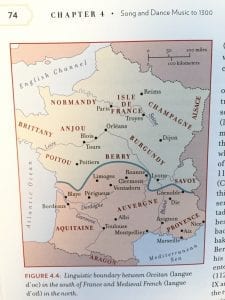Over a single week I have dived head first into the world of musical geography, transitioning from a map novice to a map critic to, finally, a map maker. While this was a very quick turnaround given my complete naïveté with maps only two weeks ago, I feel a sense of accomplishment having contributed something to the academic community, albeit the grandeur of it is not exactly grand. In both analyzing and creating maps, I would describe myself as an amateur at best, but I am optimistic about the semester of discovery to come.
In terms of the order in which I began my acquisition of mapmaking knowledge, I’m pretty glad I began by analyzing and critiquing a map before delving into making one of my own. The map that I analyzed is shown below: The Linguistic Boundaries between Occitan and Medieval French1.
In my analysis of this map, I discussed the absolute nature of the linguistic regions. These regions leave little room for interpretation and imply absolutely no nuance. If one were a composer below the border, one would be writing in Occitan French, and vice versa. The nature of this map left me questioning the certainty of the cartographer as he placed a border that cut through the middle of the map. Were there absolutely no compositions being written in the opposite language of the region? Was there more ambiguity in language closer to the border? These questions left me perplexed.
The large takeaway I got from analyzing this map is that nuance is important. Together, as a team, we have discussed in depth the simple impossibility of objectivity when making maps. When in the process of making a map, it is important to constantly keep this in the back of one’s mind. So brings us to the maps that Carolyn and I made, one which shows the origins and spread of opera in Italy by displaying Performances of the Opera Giasone, and another which displays The Origins and Spread of Opera in Europe:
I personally find a bit more nuance and open-endedness in the maps we made. While we did create the map with a goal in mind, to show the spread of opera throughout Italy and Europe, the map that we created leaves the data to do the talking. Instead of cherry picking operas that clearly display the spread of opera throughout Europe, we decided to do more of a survey of opera from 1600-1850, and let viewers discover for themselves how opera spread from Italy to other countries.
1 Burkholder, Grout, Palisca, Grout, Donald Jay, and Palisca, Claude V. A History of Western Music. Ninth ed. New York, N.Y.: W. W. Norton & Company, 2014. 74.

You must be logged in to post a comment.